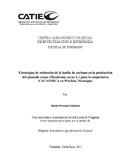| dc.contributor.advisor | Somarriba, Eduardo | |
| dc.contributor.author | Poroma Colmena, Daniel | es_ES |
| dc.date.accessioned | 2015-07-23T21:15:18Z | |
| dc.date.available | 2015-07-23T21:15:18Z | |
| dc.date.issued | 2012 | |
| dc.identifier.uri | https://repositorio.catie.ac.cr/handle/11554/7120 | |
| dc.description | Tesis (Mag. Sc. en Agroforestería Tropical) -- CATIE. Escuela de Posgrado. Turrialba (Costa Rica), 2012 | es_ES |
| dc.description.abstract | Se estimó la tasa de acumulación de carbono en nueve sistemas agroforestales de cacao entre 2009 y 2011 para la Cooperativa CACAONICA en Waslala, Nicaragua. La tasa de acumulación de la biomasa encima (árboles de sombra, cacao, hojarasca, necromasa fina y gruesa) y debajo del suelo (raíces finas y gruesas) fue de 3,3 Mg C ha-1 año-1, de los cuales 1,3 Mg C ha-1 año-1 fueron para el dosel de sombra y cacao, 0,7 Mg C ha-1 año-1 a la necromasa fina y gruesa, 0,6 Mg C ha-1 año-1 a la hojarasca y 0,7 Mg C ha-1 año-1 a la tasa de fijación por
las raíces finas y gruesas. El dosel y el cacao encima del suelo aportaron con el 21% y 18% del carbono total (biomasa encima y debajo del suelo). Los árboles frutales contribuyeron con el 63% del carbono total del dosel de sombra. Los árboles maderables de Tabebuia rosea y
Cordia alliodora redujeron anualmente 4% de su población en clases diamétricas mayores a 31 cm. Las especies de regeneración natural menores a 10 cm de diámetro guardaron una relación directa con las especies actuales de dosel, predominando en los sistemas Inga sp,
Bourreria huanita y Cordia alliodora. Se contabilizaron las emisiones de dióxido de carbono, metano y oxido nitroso que genera la producción (suelo, compost), transformación (transporte, fermentado y secado) y
comercialización (bolsas y transporte) de cacao para determinar la huella de carbono. Se estimo que 1 kg de cacao seco puede emitir a la atmosfera 4,98 kg de dióxido de carbono equivalente. El suelo y el secado a leña del cacao representaron el 77% y 14% de las
emisiones totales, siendo los mayores contribuyentes de la huella de carbono del cacao. El balance de carbono entre las remociones y emisiones mostraron que los sistemas agroforestales remueven en promedio ocho veces más dióxido de carbono del que emite la
huella de carbono del cacao (4,98 kg CO2e kg-1 cacao) llevando a la cooperativa CACAONICA hacia una neutralidad de carbono y creando oportunidades para reducir las próximas emisiones de la cadena del cacao. | es_ES |
| dc.description.abstract | Was estimated rate of carbon accumulation in nine cacao agroforestry systems between 2009 and 2011 for the Cooperative CACAONICA in Waslala, Nicaragua. The rate of biomass accumulation above (shade trees, cocoa, fine and coarse necromass and litter) and underground (fine and coarse roots) was 3,3 Mg C ha-1 year-1, where 1,3 Mg C ha-1 year-1 corresponded to the canopy of shade trees and cocoa, 0,7 Mg C ha-1 year-1 to the fine and
coarse necromass, 0,6 Mg C ha-1 year-1 to the litter and 0,7 Mg C ha-1 year-1 to the rate of fixation by the fine and coarse roots. The canopy and the Cocoa above the ground provided 21% and 18% respectively of carbon to the total accumulation rate (biomass above and below
ground)-. Fruit trees increased carbon by 63% with respect to shade trees. The timber trees of Tabebuia rosea and Cordia alliodora reduced their population in diameter classes> 31 cm by 4% annually. Natural regeneration species less than 10 cm in diameter kept a directly related to current species of canopy, redominating in the Inga sp, Bourreria huanita and Cordia alliodora systems. Were counted emissions of carbon dioxide, methane and nitrous oxide generated from
production (soil, compost), processing (transport, fermented and dried) and marketing (bags and transport) of cocoa to determine the carbon footprint. It is estimated that 1 kg of dry cocoa can emit into the atmosphere 4.98 kg of carbon dioxide equivalent. The soil and wood drying
cocoa accounted for 77% and 14% of total emissions, being the largest contributors to the carbon footprint of cocoa. The carbon balance of the removals and missions showed that agroforestry systems remove on average eight times more carbon dioxide than it releases the carbon footprint of cocoa (4.98 kg cocoa CO2e kg-1) being cooperative towards CACAONICA carbon neutrality
and creating opportunities to reduce emissions near the cocoa chain. | en_EN |
| dc.language.iso | es | es_ES |
| dc.publisher | CATIE, Turrialba (Costa Rica) | es_ES |
| dc.relation.ispartof | Magister Scientiae en Agroforestería Tropical | |
| dc.subject | THEOBROMA CACAO | |
| dc.subject | BIOMASA | |
| dc.subject | CARBONO | |
| dc.subject | ALMACENAMIENTO | |
| dc.subject | GASES DE EFECTO INVERNADERO | |
| dc.subject | CALENTAMIENTO GLOBAL | |
| dc.subject | CICLO VITAL | |
| dc.subject | BIOMASA AEREA | |
| dc.subject | BIOMASA ABAJO DEL SUELO | |
| dc.subject | HUELLA DE CARBONO | |
| dc.subject | AGROFORESTERIA | |
| dc.subject | NICARAGUA | |
| dc.title | Estrategias de reducción de la huella de carbono en la producción del grano de cacao (Theobroma cacao L.) para la cooperativa CACAONICA en Waslala, Nicaragua | es_ES |
| dc.title.alternative | Strategies to offset carbon footprint in the production of cocoa beans (Theobroma cacao L.) in Waslala, Nicaragua | es_ES |
| dc.type | Tesis de maestría | es_ES |
| dcterms.rights | acceso abierto | es_Es |
| dc.identifier.publisher | CATIE | es_ES |
| dc.identifier.publication | CATIE | es_ES |


